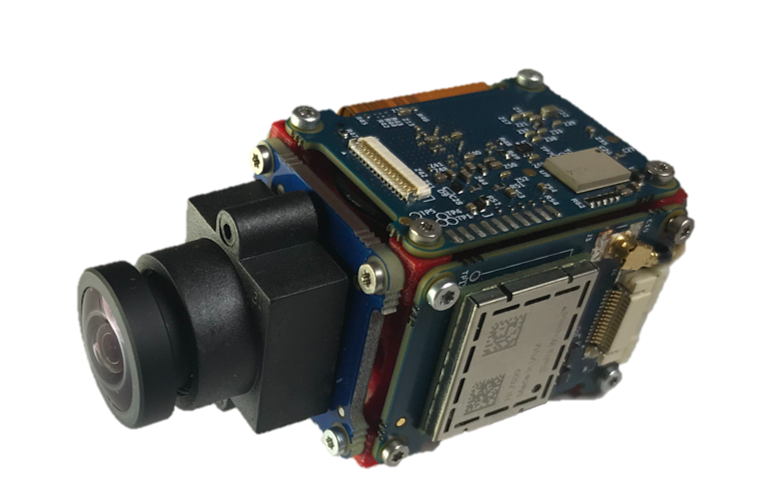This blog post was originally published at Au-Zone Technologies’ website. It is reprinted here with the permission of Au-Zone Technologies.
It wasn’t that long-ago computer vision applications with AI/ML intelligence required systems with extensive compute capability, lots of memory and high-end industrial cameras. The notion of adding computer vision with ML capability to cost sensitive IoT edge devices was more often than not overshadowed by the reality of high BOM costs which lead to low product margins for all except the most specialized applications.
Cloud based solutions provided a possible alternative by mitigating the need for resource rich computational systems at the edge. With cloud based solutions, image processing and ML inferencing could be off-loaded to resource intensive cloud computers. However, the cost of cloud platform instances, security vulnerabilities, and response-time jitter created different obstacles which served as impediments for IoT adoption.
Yet, despite all the initial setbacks, computer vision for IoT edge devices is possible. Arm’s release of the high-performance, cost sensitive Cortex-M7 architecture, coupled with the improvements in NN model optimization lay the foundation for computer vision and AI in IoT edge devices. Au-Zone Technologies’ IoT Vision Sensor leverages NXP’s Cortex-M7 based RT1060 with Au-Zone’s highly optimized DeepView ML stack to disrupt the market with a truly cost effective computer vision solution for IoT edge devices.
NXP RT1060
Arm introduced the Cortex-M7 architecture with the intention of enabling developers with IP to create cost-sensitive edge devices. NXP harnessed Arm’s Cortex M7 vision with the release of the NXP RT crossover series which bridges the gap developers often face when confronted with decisions regarding MCU price points vs MPU performance. The RT1060 offers a price point that is commensurate with MCUs; and yet the performance is comparable with modern Arm Cortex-A based MPUs.

The computational capability and connectivity options make the RT1060 ideal for low power, cost sensitive, computer vision applications in IoT edge devices.
DeepViewRT
Neural Network model optimization is critical for ML on resource limited IoT edge devices. Au-Zone, a recognized leading provider of edge-based ML solutions, delivers the tooling needed for ML optimization with the DeepView Toolkit. The DeepView Toolkit is a comprehensive AI / ML development environment complete with conversion, optimization, and profiling tools as well as the highly optimized inference engine DeepViewRT.

For example, DeepViewRT is an astonishing 1/10th the size of TF Lite. Because of the size advantage of DeepViewRT compared to other available solutions, developers can benefit from using full precision models with greater accuracy.
The DeepViewRT inference engine was designed for portability across the spectrum of cores common on today’s modern SoCs: from Cortex M to Cortex A, and GPUs. With a 2x to 4x performance advantage over TensorFlow and other open source alternatives, the highly optimized DeepViewRT inference engine proves to be an ideal solution for many computer vision applications including object detection, classification, segmentation and tracking. Support for the leading frameworks, such as TensorFlow, Caffe and others, as well as the latest NNs from portals such as TensorFlow Hub and Model Zoo allows users to bring their own models for deployment on the IoT sensor.
IoT Vision Sensor
Leveraging NXP’s RT1060 and the highly compact DeepView ML Stack, Au-Zone’s IoT Vision Sensor reference design disrupts the market with an integrated solution that includes:
- Small Form Factor
- Low BOM Cost
- Integrated AI / ML Intelligence, and
- Connectivity
This standalone IoT camera reference design has been optimized for both low power and high performance. This is the first introduction of a family of IoT Vision Sensor camera designs based on the NXP RT cross over series. Future IoT Vision Sensor product releases will include an upgrade path to the NXP.
Small Form Factor
The IoT Vision Sensor comprises a small and tight form factor with a typical board size of 25 x 25 x 40 mm (not including the antenna).

Sub $50 BOM Price Point
The IoT Vison Sensor has a disruptive BOM cost at less than $50 USD.
DeepView Toolkit
The integrated DeepViewRT inference engine has been optimized for peak performance on the RT1060. Model conversion and optimization is accomplished with the DeepView Toolkit to support a wide range of computer vision applications. Advanced image processing features include object detection using an SSD network and object classification for pre-defined regions of interest. The DeepView Toolkit streamlines the development flow for training, testing, and validating neural networks for custom data types. The IoT Vision Sensor with the DeepView Toolkit was designed to stream the development of custom ML for rapid prototyping and final product delivery.
Connectivity
Enabling ML at the edge adds the device intelligence needed to reduce data bandwidth between the device and cloud. However, for device reporting and management different connectivity options are available for either local or remote interfaces including RS-485, Ethernet, WiFi, and LPWA Modem.

The IoT Vision Sensor is a production ready solution that enables rapid development for edge-based ML computer vision applications. With advanced AI / ML capabilities in a compact form factor at a disruptive price point, it is a compelling design for applications in various vertical market segments including Industrial, Smart Home, Smart City, Consumer, Healthcare, Agriculture, Transportation and Logistics. The IoT Vision Sensor can be purchased for prototyping, development, and low volume field testing for ~ $199 USD. Additionally, the hardware design and software can be licensed by OEMs for production. Visit www.embeddedml.com for more information.
Brad Scott
Co-founder and President, Au-Zone Technologies


